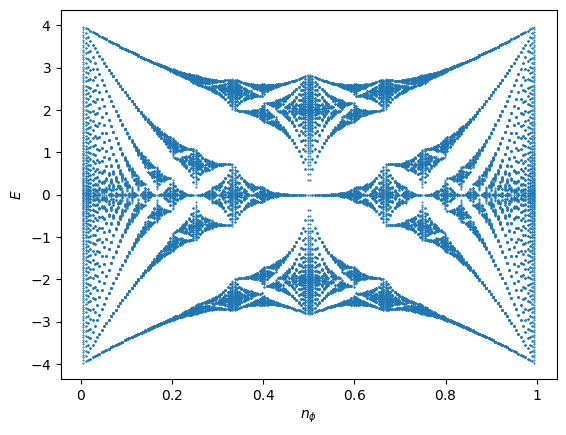Butterfly
In this tutorial, we discuss the internals of the butterfly program, used for plotting the energy spectrum of the Hofstadter model at fixed momentum \(\mathbf{k}=\mathbf{0}\) for a range of flux densities \(n_\phi=p/q\), where \(p\) and \(q\) are coprime integers. The code in this notebook is equivalent to running the command butterfly -lat square -q 199.
Import the necessary namespace libraries. Note that library imports are segregated into
external importsfrom the Python environment andinternal importsfrom HT.
[1]:
# --- external imports
import numpy as np
import matplotlib.pyplot as plt
from tqdm import tqdm
from math import gcd
import matplotlib.ticker as ticker
# --- internal imports
from HT.models.hofstadter import Hofstadter
Read in the inputs for the program. On the command line, these arguments are parsed from the input flags. For this notebook, however, we hard-code a minimal set of input values.
[2]:
q = 199
Loop through \(p\) values such that \(n_\phi=p/q\) is rational. On each \(p\) iteration, construct the model, define the flux density, and diagonalize the Hamiltonian at \(\mathbf{k}=\mathbf{0}\).
[3]:
nphi_list = []
E_list = []
for p in tqdm(range(1, q), desc="Butterfly Construction", ascii=True):
# construct model
model = Hofstadter(p, q, lat="square")
# define flux density
if gcd(p, q) != 1: # nphi must be a coprime fraction
continue
nphi = p/q
# diagonalize Hamiltonian
ham = model.hamiltonian(np.array([0, 0]))
M = len(ham)
nphi_list.append([nphi] * M)
lmbda = np.sort(np.linalg.eigvalsh(ham))
E_list.append(lmbda)
Butterfly Construction: 100%|##########| 198/198 [00:02<00:00, 66.26it/s]
Plot the butterfly spectrum.
[4]:
fig = plt.figure()
ax = fig.add_subplot(111)
nphi_list = list(np.concatenate(nphi_list).ravel())
E_list = list(np.concatenate(E_list).ravel())
ax.scatter(nphi_list, E_list, s=1, marker='.')
ax.set_ylabel('$E$')
ax.set_xlabel('$n_\phi$')
ax.xaxis.set_major_formatter(ticker.FormatStrFormatter('$%g$'))
ax.yaxis.set_major_formatter(ticker.FormatStrFormatter('$%g$'))

That’s it! You have successfully plotted the butterfly spectrum for the Hofstadter model with flux densities \(n_\phi=p/199\). Now, we can pause to comment on how the spectrum is interpreted. As we saw in the band structure tutorial, the bands of the Hofstadter model are not flat. However, as we approach the continuum limit \(q\to\infty\) the bands tend to Landau levels, which are flat, and therefore can be represented by individual points. In HofstadterTools, we use the
\(\Gamma\)-point (\(\mathbf{k}=\mathbf{0}\)) to construct the butterfly spectra. Apart from choosing a large value of \(q\) to ensure that the bands are approximately flat, it is most effective to also choose a prime number, such that we generate the maximal set of coprime fractions \(n_\phi=p/q\). Finally, we note the periodicity of the spectrum. The fact that the \(n_\phi=0,1\) spectra are identical is because we have captured the entire butterfly and, hence, have defined
the flux density with respect to an area that is minimal for the model. By default, HofstadterTools defines the flux density with respect the lattice unit cell area, however if there is a different area scale in the problem, this may need to be adjusted using the --periodicity flag.